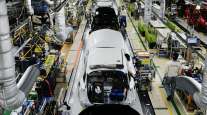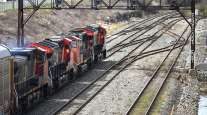NTSB Rules Crew Was Likely Asleep During Fatal Arkansas Freight Train Crash

The collision Aug. 17, 2014, in Hoxie, Arkansas, could have been prevented by an automatic braking system that Congress has required railroads to install by 2018, according to the National Transportation Safety Board.
"Human operators can be fatigued, impaired, distracted or medically unfit, and they can make errors even on their best days," said Christopher Hart, the board chairman. "This technological safety net is indispensable," he said of automatic braking.
The collision derailed 55 cars, and a diesel-fuel spill and a tank car leaking alcohol for consumption caught fire. About 500 people were evacuated within 1.5 miles of the crash.
A southbound train collided into a northbound train that was turning onto an adjacent track. The southbound train passed two yellow warning lights and a red signal without slowing down and with no sign of activity in the train’s cab before the collision, investigators said.
The board found no fault with northbound crew members, who had no time to apply brakes before the collision. The northbound crew members were seriously injured but survived the crash.
The southbound train had an automated alarm that could have given visual and audio warnings to the crew. But the warning didn’t sound because it interpreted the train’s automated horn signal as someone operating the controls, investigators said. The safety board previously issued warnings to the Federal Railroad Administration and railroads about the flaw in the automated warning system.
Both crew members who died in the 2:28 a.m. accident were presumed fatigued and were likely asleep, the board agreed.
The engineer suffered moderate sleep apnea diagnosed in 2010, which can interrupt breathing during sleep, investigators said. Union Pacific didn't require the engineer to report his condition. The conductor worked irregular shifts that could have left him tired, investigators said.
The board previously noted sleep-apnea problems among train crew members in accidents in Clarkston, Michigan, in 2001; Red Oak, Iowa in 2011; Chaffee, Missouri, in 2013; and in a Bronx, New York, commuter-rail accident in 2013.
Board member Earl Weener noted airlines anticipate crew members will make mistakes and therefore have layers of safety features to prevent or mitigate problems. “In this case, we were not-very-many layers away from a catastrophe,” Weener said.
The other major concern in the accident dealt with automatic braking systems, also called positive train control, that railroads are installing. The systems with communications between dispatchers, track-side monitors and locomotives are geared to reduce or stop trains automatically based on speed limits and track conditions.
Board member Bella Dinh-Zarr voted against the official probable cause of the accident as the train crew's fatigue because she argued that automatic braking should have been ruled a primary cause of the accident, not just a contributing factor.
"It's only a matter of time until the epidemic of catastrophic PTC-preventable accidents is also eradicated," said Dinh-Zarr.
After a 2008 passenger-train crash in California, Congress ordered all railroads to install an automatic braking system by the end of 2015. But because of the cost and technological hurdles, it extended the deadline to the end of 2018, with an option for the transportation secretary to extend a railroad’s deadline through 2020.
An estimated 81% of railroads are expected to meet the 2018 deadline and the rest by 2020, investigators said.
Union Pacific Railroad had installed the trackside equipment necessary for automatic braking at the accident site and was testing software as it installed equipment on locomotives, investigators said.




